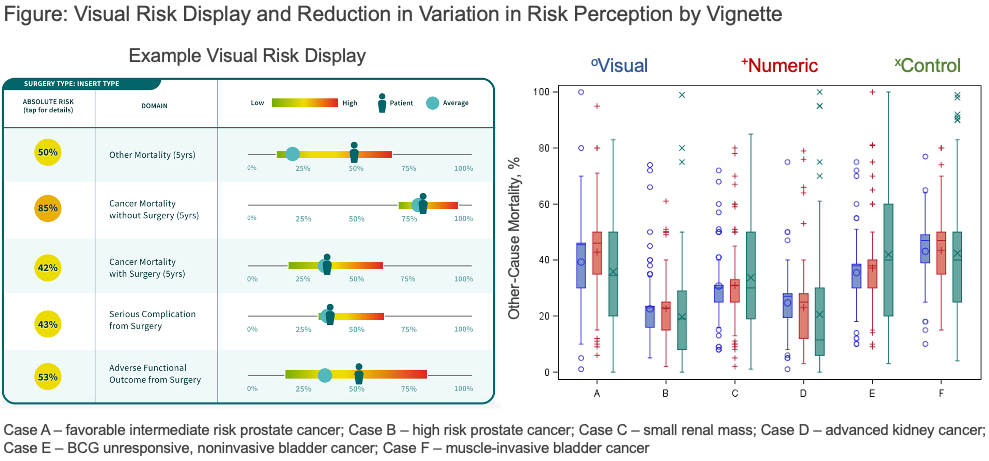Back
Introduction: Differences in risk perception is a major driver of variation in surgery. Risk prediction tools aim to attenuate these differences, but only a minority of urologists use them. Because data visualization can improve engagement and information processing, we designed a visual risk display and tested its impact on surgeon risk perception.
Methods: Taking a user-centered design approach, the research team engaged a panel of urologists to identify key risk domains and design a visual risk display. From May–June 2022, we administered SUO/AUA members 6 clinical vignettes (A: favorable intermediate risk prostate cancer, B: high risk prostate cancer, C: small renal mass, D: advanced kidney cancer, E: BCG unresponsive, noninvasive bladder cancer, F: muscle-invasive bladder cancer), randomizing them to vignettes plus visual risk display, vignettes plus numeric risk information, and vignettes alone (control). Respondents estimated the risk for other-cause mortality, cancer mortality with/without surgery, serious complications, and adverse functional outcome from 0–100%. Variation was compared using Levene’s test of homogeneity in variance.
Results: In total, 333 urologists completed all 6 vignettes with 104 in the visual arm, 111 in the numeric arm, and 118 in the control arm. Most respondents obtained fellowship-training (71.2%) and practice in an academic setting (60.1%). Respondents had 11.7 (SD 10.6) years of experience and performed 11.2 (SD 9.7) major cases per month. As illustrated in the Figure, both visual and numeric risk information reduced variation in perceived risk of other-cause mortality (i.e., life expectancy) compared to control (p < 0.05). Visual and numeric risk information yielded similar reductions in variation for the other risk domains. However, compared to numeric risk information only, the visual risk display only reduced variation in perceived risk for adverse functional outcomes for cases D, E, and F (p < 0.05).
Conclusions: Providing urologists with risk information—whether visual or numeric—reduces variation in perceived risk, particularly for life expectancy and functional outcomes. Additional research is needed to assess whether visual methods further enhance usability and risk communication in the clinical setting. SOURCE OF
Funding: American Cancer Society

Podium Session
Session: PD32: Health Services Research: Practice Patterns, Quality of Life and Shared Decision Making IV
PD32-12: Visual and numeric risk information reduces variation in surgeon risk perception: results from a randomized, clinical vignette experiment
Sunday, April 30, 2023
2:50 PM – 3:00 PM CST
Location: S501A
- HT
Podium Presenter(s)
Introduction: Differences in risk perception is a major driver of variation in surgery. Risk prediction tools aim to attenuate these differences, but only a minority of urologists use them. Because data visualization can improve engagement and information processing, we designed a visual risk display and tested its impact on surgeon risk perception.
Methods: Taking a user-centered design approach, the research team engaged a panel of urologists to identify key risk domains and design a visual risk display. From May–June 2022, we administered SUO/AUA members 6 clinical vignettes (A: favorable intermediate risk prostate cancer, B: high risk prostate cancer, C: small renal mass, D: advanced kidney cancer, E: BCG unresponsive, noninvasive bladder cancer, F: muscle-invasive bladder cancer), randomizing them to vignettes plus visual risk display, vignettes plus numeric risk information, and vignettes alone (control). Respondents estimated the risk for other-cause mortality, cancer mortality with/without surgery, serious complications, and adverse functional outcome from 0–100%. Variation was compared using Levene’s test of homogeneity in variance.
Results: In total, 333 urologists completed all 6 vignettes with 104 in the visual arm, 111 in the numeric arm, and 118 in the control arm. Most respondents obtained fellowship-training (71.2%) and practice in an academic setting (60.1%). Respondents had 11.7 (SD 10.6) years of experience and performed 11.2 (SD 9.7) major cases per month. As illustrated in the Figure, both visual and numeric risk information reduced variation in perceived risk of other-cause mortality (i.e., life expectancy) compared to control (p < 0.05). Visual and numeric risk information yielded similar reductions in variation for the other risk domains. However, compared to numeric risk information only, the visual risk display only reduced variation in perceived risk for adverse functional outcomes for cases D, E, and F (p < 0.05).
Conclusions: Providing urologists with risk information—whether visual or numeric—reduces variation in perceived risk, particularly for life expectancy and functional outcomes. Additional research is needed to assess whether visual methods further enhance usability and risk communication in the clinical setting. SOURCE OF
Funding: American Cancer Society

